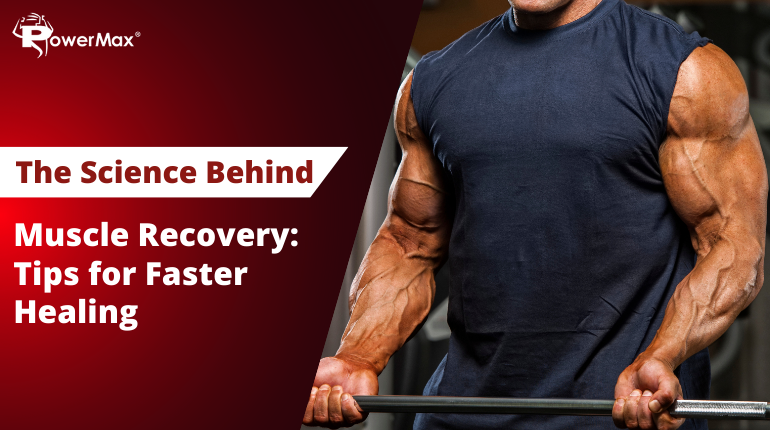Muscle recovery is an essential element of fitness that is often disregarded on the journey of building strength and endurance. Regardless of whether you’ve just begun strength training or are an experienced athlete, knowledge of the science behind muscle recovery is essential. This knowledge will take you far. You’ll be able to stick to a regular training schedule without injuries and impactful results. This blog will explore the biochemistry of muscle regeneration and offer practical advice for accelerated healing without being too preachy.
What Happens During Muscle Recovery?
To begin with, during high-intensity activity, your muscle fibers tend to develop small tears, during strength training. This is called DOMS (Delayed Onset Muscle Soreness). These little tears improve muscle growth and are a normal reaction to stress. Your body works hard to strengthen these fibers as it heals them. But regaininf muscle strength and recovery involves more than merely waiting for muscles to "heal."
Following a workout, muscle healing happens in three main stages:
There are three main phases of muscle recovery:
The Inflammatory Response
Inflammation is characterized by redness, swelling, heat, pain, and sometimes loss of function in the affected area. After a workout, your body initiates an inflammatory response. Your muscles experience tears after exercise, especially if the actions are difficult or unusual. The body responds by increasing blood flow to the affected area, to remove damaged cells and clear the area for new tissue. This phase typically lasts a few hours to a day.
Muscle Repair and Regeneration
Specialized cells called satellite cells are activated during the next phase of recovery. These specialized cells merge with already existing muscle tissue. This is when your muscles begin to grow and strengthen. This phase can last several days, depending on the intensity of your workout.
Muscle Remodeling
The final phase involves the strengthening and restructuring of muscle fibers. Muscle remodeling strengthens fibers to better handle future stress, reducing the risk of injury in later exercises. Focus on a balanced protein intake that helps tissue repair throughout the muscle remodeling period. You should also make sure you consume enough carbohydrates and healthy fats for energy, as well as enough vitamins and minerals to support muscle growth and recovery. Rest and stretching are also vital in this stage.
Factors Influencing Muscle Recovery
Several factors affect how quickly and efficiently your muscles recover:
Intensity and duration: Workouts with higher intensity cause more muscle damage compared to more lax exercises and take longer to recover.
Age: The body’s ability to regenerate cells decreases as we age, hence muscle repair slows down.
Nutrition: Protein, carbohydrates, and healthy fats play a significant role not only in replenishing energy but also in muscle repair. As we know post-workout nutrition also helps in muscle recovery depending on your post-workout meal so don't forget to eat your post-workout meal
Sleep: Deep sleep is when the body produces growth hormones. These hormones are critical for muscle recovery and regeneration. the impact of deep sleep on your gym recovery and performance.
Tips for Faster Muscle Recovery
Stay Hydrated
One of the most overlooked components for muscle regeneration is hydration. Water eliminates toxins from your body and delivers nutrients to your muscles. However, dehydration makes these processes less efficient. Make sure you are drinking enough water during the day, and most importantly after an exercise.
Prioritize Protein Intake
Since protein is the building ingredient of muscle tissue, getting enough of it during recovery is essential. For your post-workout meal, 20–30 grams of protein can aid the process of muscle regeneration. Lean meats, seafood, eggs, and plant-based sources like lentils and chickpeas are healthy sources of protein.
Incorporate Active Recovery
For active recovery, turn to activities that increase blood flow without putting too much strain on your muscles. Walking, cycling, and swimming are great low-intensity workouts that you can do to improve blood flow. These exercises carry more oxygen and nutrients to the muscles, speeding the mending process.
Get Enough Sleep
Getting a good night's sleep is the most irreplaceable step in recovery and restoring muscle fibers. Human growth hormone (HGH), which is produced by the body during deep sleep, is essential for restoring muscles. 7 to 9 hours of sleep per night are apt for optimal results.
Use Foam Rolling and Stretching
Foam rolling improves blood flow to tense muscle knots and otherwise, these speed up the process of healing. Use foam rollers alongside your dynamic stretching to improve your range of motion, enhance discomfort, and increase flexibility.
Optimize Post-Workout Nutrition
Protein and carbohydrates work together to replenish the glycogen stores used up during exercise. Protein and carbohydrates should be included in a balanced post-workout meal; try chicken with brown rice or a protein powder and fruit smoothie.
Take Rest Days Seriously
Taking days off is not a sign of weakness. It is necessary for long-term growth. Overtraining without recuperation time can result in burnout. To ensure that your muscles have enough time to heal, try to include at least two days of rest per week.
Cold Therapy and Heat Therapy
By narrowing blood vessels, cold therapy—such as ice baths or cold showers—tends to narrow down the blood vessels being transported to the muscles. Cold therapy reduces inflammation and pain in the affected areas. But in the later stages of recovery, heat therapy helps relax tense muscles and improves blood flow.
Supplement Wisely
Certain supplements, such omega-3 fatty acids and branched-chain amino acids (BCAAs), can help with muscle revival. While omega-3s have anti-inflammatory qualities that can reduce discomfort, BCAAs aid in reducing muscle damage. But before turning to supplements, remember, that rather than taking the place of a well-balanced diet, supplements should enhance it.
Conclusion
Resting is only one aspect of muscle recovery; you also need to actively aid in your body's repair process. You may accelerate muscle regeneration and return to your workouts stronger than before by drinking plenty of water, making the most of your diet, getting enough sleep, and using active recovery strategies. Your risk of injury will be lower if you balance exercise intensity with enough recovery. This will also improve your overall performance and help you reach your fitness objectives.
 India (INR)
India (INR)
 UAE (AED)
UAE (AED)
 Store Locator
Store Locator



-thumb.jpg)
-thumb.jpg)
-thumb.jpg)
-thumb.jpg)
-thumb.jpg)
-thumb.jpg)
-thumb.jpg)

-thumb.jpg)
-thumb.jpg)